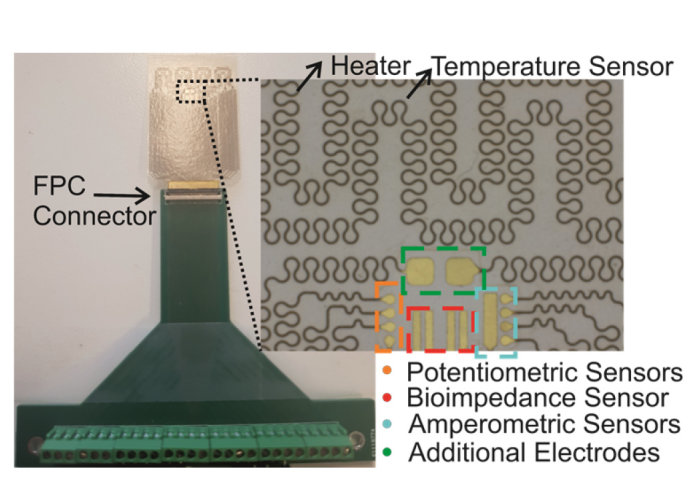A Flexible/Stretchable Multiparametric Sensing Device

Hamlyn researchers proposed a novel flexible/stretchable device to overcome the drawbacks of traditional rigid electronics in biomedical applications.
There have recently been tremendous advances in materials, fabrication methods and geometrical designs for flexible/stretchable electronics. Such technologies are critical for wearable, implantable, soft robotic and surgical devices.
Traditional rigid electronics based on off-the-shelf components on rigid FR4 printed circuit boards (PCB) or microfabrication techniques based on rigid silicon wafers, are not ideal in many biomedical applications as the human body is not a flat rigid surface; it is soft and subject to mechanical motions.
Traditional electronics will thus become damaged, while also damaging tissue and skin. Hence, there is a need for flexible, stretchable and soft wearable and implantable devices that can be seamlessly integrated into the everyday life of their users, without hindering their daily routines or creating additional psychological burden, discomfort or other complications to patients.
A Flexible/Stretchable Multi-parametric Sensing Device for Surgical Applications
Our research team at the Hamlyn Centre presented a novel flexible and stretchable multi-parametric device for surgical and wearable applications, realised via a commercial process. This is comprised of horseshoe interconnects, electrochemical sensor electrode arrays, a heater for thermotherapy/thermo-regulation, a temperature sensor, electrodes for recording/applying signals to tissues and a bioimpedance sensor.

The electrochemical deposition of Pt black, Au and IrOx were presented.
To carry out the assessment and comparison with unmodified electrodes, the SEM images analysis and EDS analysis of their characteristics was performed, as well as EIS spectra.
The heater temperature and impedance sensors were characterised and preliminary results from the pH sensor were also shown in this research.
Our researchers plan to work on the realisation of electrochemical sensors for glucose, lactate, K+, Na+, examination of the effect of mechanical deformations on sensor responses and further in vitro but also in vivo and in situ experimentation with the proposed device.
This research was supported by EPSRC Programme Grant “Micro-robotics for Surgery (EP/P012779/1)” and was published in 2019 IEEE Biomedical Circuits and Systems Conference (BioCAS) ( and Guang-Zhong Yang, "Towards a Flexible/Stretchable Multiparametric Sensing Device for Surgical and Wearable Applications").
Article supporters
Article text (excluding photos or graphics) © Imperial College London.
Photos and graphics subject to third party copyright used with permission or © Imperial College London.
Reporter
Erh-Ya (Asa) Tsui
Enterprise